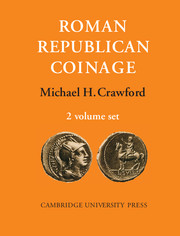Book contents
- Frontmatter
- Contents
- VOLUME I
- INTRODUCTION
- CATALOGUE
- VOLUME II
- misc-frontmatter
- 1 Technique and Technology
- 2 Weight Standards
- 3 Monetary Magistrates
- 4 Special Formulae
- 5 Administration and Control
- 6 Roman Units of Reckoning Under the Republic
- 7 Coinage and Finance
- 8 Careers of the Moneyers
- 9 Types and Legends
- 10 Art and Coinage
- Plates
- Indices
- Plate section
10 - Art and Coinage
from VOLUME II
Published online by Cambridge University Press: 07 October 2011
- Frontmatter
- Contents
- VOLUME I
- INTRODUCTION
- CATALOGUE
- VOLUME II
- misc-frontmatter
- 1 Technique and Technology
- 2 Weight Standards
- 3 Monetary Magistrates
- 4 Special Formulae
- 5 Administration and Control
- 6 Roman Units of Reckoning Under the Republic
- 7 Coinage and Finance
- 8 Careers of the Moneyers
- 9 Types and Legends
- 10 Art and Coinage
- Plates
- Indices
- Plate section
Summary
Republican coinage, in its artistic aspect, presents the same problem as does Roman art in general. The earliest Republican didrachms would be indistinguishable from Greek didrachms were it not for the ethnic, whereas the coinage of Caesar is ‘obviously Roman'. Similarly, the relief ofL. Aemilius Paullus at Delphi is Roman only by reason of its dedicator, whereas no-one would regard the triumphal relief from the Via del Mare as anything but Roman.
The coinage of the Republic, however, is particularly important because it provides both the earliest evidence and the most continuous evidence for the history of Roman art; it is in consequence surprising to find that although lip-service is often paid to the importance of all this evidence, linl,e serious use is made ofit. All that I feel able to do here is to make a series of observations about some aspects of the artistic side of the coinage of the Republic.
In the first place it is desirable to be aware of the extent to which the artists who cut the dies were independent agents. This shows in all sorts oflinle ways, in the casual introduction of a variant obverse type for the semuncia on an early bronze issue (no. 160/5), in the gradual substitution of a head of Mercury with a caduceus over his shoulder for a simple head of Mercury as the obverse type of the sextans, in the occasional use for the reverse type of the quadrans of attributes of Hercules, who forms the obverse type. The series of reverse types in the mid-second century portraying chariots drawn by bizarre animals is presumably the result of a passing artistic fashion; equally it is apparent that even in the relatively tightly controlled coinages of 44 and 42 spelling was a matter to be settled according to the whims of the individual engraver.
There is also evidence that insofar as Republican die engravers used models at all, they tended to use numismatic models; the most striking example is provided by the restored denarii of 82 (nos. 369-71), deriving their reverse types from denarii of the second half of the second century; it is also worth drawing attention to those cases where the bronze types of one moneyer are copied from the silver types of another moneyer of the same year.
- Type
- Chapter
- Information
- Roman Republican Coinage , pp. 745 - 754Publisher: Cambridge University PressPrint publication year: 1975



